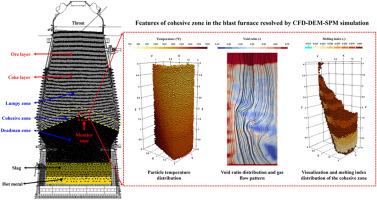CFD-DEM-SPM modeling of permeability and pressure drop in cohesive zones of heterogeneous alternating layer beds for low-carbon blast furnace ironmaking
IF 4.3
2区 材料科学
Q2 ENGINEERING, CHEMICAL
引用次数: 0
Abstract
To reduce greenhouse gas emissions in ironmaking, the steel industry is advancing innovative low-carbon blast furnace (BF) technologies. A critical challenge for implementing such innovations lies in optimizing permeability within the BF's cohesive zone (CZ), which directly impacts operational stability and efficiency. This study employs a coupled computational fluid dynamics-discrete element method (CFD-DEM) to calibrate Young's modulus by respectively fitting the relationship between Young's modulus and temperature, as well as pressure drop, based on a reported lab-scale softening and smelting experimental data of ore-coke heterogeneous alternating layer packed beds resembling BFs, and develops a softening particle model (SPM). The SPM establishes a temperature-dependent relationship between mechanical properties of softened ore particles and CZ conditions in industrial-scale BFs. Simulations of particle shrinkage behavior and pressure drop trends using the CFD-DEM-SPM framework demonstrate strong correlation with experimental data, validating its accuracy for predictive analysis. Furthermore, this study investigates how layer arrangement configurations, size ratios between ore and coke particles, and coke blending proportions influence CZ characteristics. Key findings identify an optimal batch weight configuration to enhance permeability within the CZ while maintaining operational stability. Additionally, results indicate that increasing the relative particle size of ore compared to coke or enhancing the proportion of blended coke in burden mixes improves CZ permeability, offering actionable strategies for reducing carbon intensity in BF operations. These insights provide critical guidance toward developing low-carbon BF processes compatible with global climate targets.

低碳高炉炼铁非均质交变层床黏结带渗透率和压降的CFD-DEM-SPM模型
为了减少炼铁过程中的温室气体排放,钢铁行业正在推进创新的低碳高炉(BF)技术。实施这些创新的一个关键挑战在于优化高炉内聚层(CZ)的渗透率,这直接影响到运行的稳定性和效率。本研究基于已报道的类似BFs的矿焦非均质交替层充填床软化和冶炼实验数据,采用计算流体动力学-离散元耦合方法(CFD-DEM)分别拟合杨氏模量与温度和压降的关系,对杨氏模量进行标定,并建立软化颗粒模型(SPM)。SPM建立了工业规模高炉中软化矿石颗粒的力学性能与CZ条件之间的温度依赖关系。利用CFD-DEM-SPM框架对颗粒收缩行为和压降趋势进行了模拟,结果与实验数据具有很强的相关性,验证了其预测分析的准确性。此外,本文还研究了层状排列构型、矿石与焦炭颗粒粒度比以及焦炭掺混比例对CZ特性的影响。主要研究结果确定了最佳的批重量配置,以提高CZ内的渗透率,同时保持操作稳定性。此外,研究结果表明,增加矿石相对于焦炭的相对粒度或提高混合焦炭在炉料中的比例可以提高CZ的渗透率,为降低高炉运行中的碳强度提供了可行的策略。这些见解为开发符合全球气候目标的低碳高炉工艺提供了重要指导。
本文章由计算机程序翻译,如有差异,请以英文原文为准。
求助全文
约1分钟内获得全文
求助全文
来源期刊

Particuology
工程技术-材料科学:综合
CiteScore
6.70
自引率
2.90%
发文量
1730
审稿时长
32 days
期刊介绍:
The word ‘particuology’ was coined to parallel the discipline for the science and technology of particles.
Particuology is an interdisciplinary journal that publishes frontier research articles and critical reviews on the discovery, formulation and engineering of particulate materials, processes and systems. It especially welcomes contributions utilising advanced theoretical, modelling and measurement methods to enable the discovery and creation of new particulate materials, and the manufacturing of functional particulate-based products, such as sensors.
Papers are handled by Thematic Editors who oversee contributions from specific subject fields. These fields are classified into: Particle Synthesis and Modification; Particle Characterization and Measurement; Granular Systems and Bulk Solids Technology; Fluidization and Particle-Fluid Systems; Aerosols; and Applications of Particle Technology.
Key topics concerning the creation and processing of particulates include:
-Modelling and simulation of particle formation, collective behaviour of particles and systems for particle production over a broad spectrum of length scales
-Mining of experimental data for particle synthesis and surface properties to facilitate the creation of new materials and processes
-Particle design and preparation including controlled response and sensing functionalities in formation, delivery systems and biological systems, etc.
-Experimental and computational methods for visualization and analysis of particulate system.
These topics are broadly relevant to the production of materials, pharmaceuticals and food, and to the conversion of energy resources to fuels and protection of the environment.
 求助内容:
求助内容: 应助结果提醒方式:
应助结果提醒方式:


